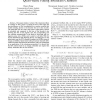Free Online Productivity Tools
i2Speak
i2Symbol
i2OCR
iTex2Img
iWeb2Print
iWeb2Shot
i2Type
iPdf2Split
iPdf2Merge
i2Bopomofo
i2Arabic
i2Style
i2Image
i2PDF
iLatex2Rtf
Sci2ools
CORR
2007
Springer
2007
Springer
Writing on Dirty Paper with Resizing and its Application to Quasi-Static Fading Broadcast Channels
— This paper studies a variant of the classical problem of “writing on dirty paper” in which the sum of the input and the interference, or dirt, is multiplied by a random variable that models resizing, known to the decoder but not to the encoder. The achievable rate of Costa’s dirty paper coding (DPC) scheme is calculated and compared to the case of the decoder’s also knowing the dirt. In the ergodic case, the corresponding rate loss vanishes asymptotically in the limits of both high and low signal-to-noise ratio (SNR), and is small at all finite SNR for typical distributions like Rayleigh, Rician, and Nakagami. In the quasi-static case, the DPC scheme is lossless at all SNR in terms of outage probability. Quasi-static fading broadcast channels (BC) without transmit channel state information (CSI) are investigated as an application of the robustness properties. It is shown that the DPC scheme leads to an outage achievable rate region that strictly dominates that of time divi...
Achievable Rate | CORR 2007 | DPC Scheme | Education | Paper |
| Added | 13 Dec 2010 |
| Updated | 13 Dec 2010 |
| Type | Journal |
| Year | 2007 |
| Where | CORR |
| Authors | Wenyi Zhang, Shivaprasad Kotagiri, J. Nicholas Laneman |
Comments (0)

